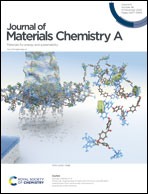A strain-adaptive, self-healing, breathable and perceptive bottle-brush material inspired by skin†
Abstract
Notwithstanding the substantial progress of human skin bionics, it remains an enormous challenge to integrate skin-like softness, strain-adaptability, self-healing ability, breathability and perceptiveness in a single material. Herein, a multi-skin-function mimetic material is developed based on bottle-brush molecular design and dynamic ionic crosslinking through reacting the inherent terminal bromines of the branch chains with 4-dimethylaminopyridine. The material manifests a shear modulus as low as 46 kPa, obvious strain-adaptive behaviour, and a self-healing efficiency of 98% at room temperature. Taking advantage of the super softness, sensor devices based on the material are highly sensitive to deformation with a gauge factor of 14 500. Moreover, the high free volume leads to vapor permeability of the material, which enables the embedded fluorophores to sense chemical stimuli. Therefore, this material can mimic the diverse functions of the skin, and thus hold great potential for applications such as artificial skin, smart soft robots and wearable devices.



 Please wait while we load your content...
Please wait while we load your content...